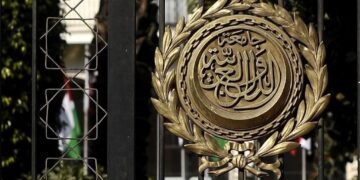Relations between Arab countries are characterized by a special nature based on shared Arab national and cultural affiliation. This is despite the Arab world’s vast geographical area, extending from the Indian Ocean and the Arabian Gulf in the east to the Atlantic Ocean in the west. This is accompanied by diverse terrain and even differences in social development between countries, due to numerous factors, the most important of which is that many Arab countries were subject to foreign colonialism for long periods.
Nevertheless, a distinctive pattern can be observed in political relations between Arab countries, not to mention the emotional bond between Arab peoples based on a sense of shared national belonging. While this belonging is based on a shared culture, history, civilization, and language, for certain periods in the twentieth century it took the form of a political ideology. Despite the waning role of Arab nationalist ideologies and the increasing inter-Arab disputes, the sense of shared national belonging continues to play a pivotal role in determining the foreign policy of Arab countries and remains one of the most important determinants of Arab public opinion. This political-national bond is known as the Arab regional system, of which the Arab League is the institutional expression.
Characteristics of Arab nationalism
Arab nationalism is a political and cultural idea that holds that Arabs constitute a single nation, united by a common language, culture, history, and destiny. This nation must unite into a single political entity, or at least cooperate within a common renaissance project. Sati’ al-Husri, one of the most prominent theorists of Arab nationalism, defines the nation as “a group of people united by a common language, history, and interests—a natural bond that transcends political and religious boundaries” (al-Husri, 1968).
Nationalism among Arabs has the same humanitarian connotations as other peoples, but without racism, chauvinism, or superiority over others, as it does among European peoples, for example, and even among the Turks, Persians, and others. Because the Arab nationalist movement—in the figurative sense here—was born in the midst of struggle and combat against colonialism and foreign domination, and through this national struggle and nationalist struggle, it became one of the “national liberation movements” with a humanitarian bent, and not a racist, chauvinistic movement as are the European nationalist movements and some other nationalist movements in the region. (Al-Nasser, 2022)
Arab nationalism also differs from European nationalism in terms of origin, content, and objectives. While the European nation-state emerged following the Treaty of Westphalia in 1648 and centered around the concepts of sovereignty and citizenship, Arab nationalism emerged as a reaction to foreign domination and was liberationist and anti-colonial in nature. Furthermore, the definition of nationalism in the European context was sometimes based on racial or ethnic affiliation, as in Germany, or on legal citizenship, as in France. Arab nationalism, on the other hand, was founded on the unity of language and culture, making it inclusive of Arabs of diverse origins as long as they shared the Arab linguistic and cultural space.
Regarding the relationship with religion, European nationalism was often based on the principle of separating religion from state. Arab nationalism, on the other hand, treated Islam as an important cultural and civilizational component, without necessarily considering it the foundation of national identity. This led to divergent positions between it and Islamist movements. At the level of political ambition, European nationalism sought to unite similar peoples into nation-states, as occurred in Germany and Italy, while Arab nationalism sought a comprehensive Arab unity that transcended the borders of individual states.
The emergence and development of Arab nationalism
The Arab world first encountered the concept of European nationalism during the French campaign in Egypt at the beginning of the nineteenth century, and then through Arab students and Arab study missions in Europe in the middle of the century. However, the transformation of Arab nationalism into a cultural and political movement did not take its final form until the rise of Turkish nationalism and the beginning of the Turkification policy in the Ottoman Empire in the second half of the twentieth century. This necessitated a reaction in the Arab countries, especially those close to Turkey, such as Syria and Lebanon. In its early days, the Arab nationalist movement called for a form of self-rule and respect for Arab privacy within the framework of the Ottoman Empire. The option of an independent state was not on the table at that time due to the predominance of Islamic religious ties. (Abbas, 2007)
Following the 1908 coup that ended the rule of Sultan Abdul Hamid II and brought the Union and Progress Party to power, the policies of Turkish nationalists began to become clear. They sought to impose Turkish hegemony and a policy of Turkification on the peoples of the Ottoman Empire. This trend led Arab nationalists to consider the project of a unified, independent Arab state, which was the primary motivation for the Great Arab Revolt and the fight against the Ottoman Empire during World War I. (Abbas, 2007)
After the defeat of the Ottoman Empire in World War I and the fall of many of its Arab provinces under the control of France and Britain, which decided to divide the region into zones of influence and control in what became known as the Sykes-Picot Agreement (Afan, 2016), the Arab state emerged for the first time, albeit in the form of separate nation-states distributed among different ruling systems. The declaration of the end of the Ottoman Caliphate and the emergence of the Turkish Republic also led to political reactions in the Arab world to compensate for the end of the idea of the Islamic Caliphate. This reaction took two forms: the first was the growing momentum of Arab nationalist ideas and the rise of demands for the establishment of an independent and unified Arab state. The second form was represented by the emergence of the Muslim Brotherhood movement in Egypt, which called for the return of the Islamic Caliphate.
With the spread of Arab nationalist awareness, the adoption by various Arab elites of the discourse of Arab unity, the growing influence of colonial powers in the Arab region, and the beginning of the rise of nationalist movements in Europe, whether in Germany or Italy, the Arab nationalist discourse escalated to the point that neither the ruling Arab regimes nor the colonial powers in the region, especially Britain, could ignore it. The establishment of the League of Arab States in March 1945 came as a response, albeit minimal, to the demands of the Arab nationalist movement.
Arab nationalism as a political ideology
In the first half of the twentieth century, the Arab world witnessed a remarkable rise in nationalist ideas calling for the unity of the Arab nation based on a shared language, culture, and history, in the face of Western colonialism and the political fragmentation imposed by agreements such as Sykes-Picot. This was followed by the establishment of the State of Israel in 1948, and the failure of the ruling Arab regimes at the time to prevent the loss of Palestine. This intellectual and political climate contributed to the emergence of a number of Arab nationalist movements embracing specific political ideologies. The most prominent of these movements were the Arab Socialist Ba’ath Party, the Arab Nationalist Movement, and Nasserism. Despite the diverse backgrounds and circumstances in which these movements emerged, they shared a belief in the idea of a single Arab nation and the importance of national liberation, national unity, and social justice.
First: The Arab Socialist Ba’ath Party:
The Ba’ath Party was founded in Syria in 1947 by Michel Aflaq and Salah al-Din al-Bitar, and was an extension of earlier ideas that had been proposed since the 1930s. Its ideology combined Arab nationalism and socialism, calling for “the unity of the Arab nation, its freedom, and the achievement of socialism.” The party adopted a modernist concept of the nation based on cultural and linguistic affiliation, while rejecting any ethnic or religious division. It emphasized the need to build a unified Arab state capable of confronting colonialism and achieving social justice. (Dandashli, 2023)
The party’s most notable successes were its seizure of power in Syria in 1963 and then in Iraq in 1968. However, the two experiences later developed in divergent directions, dominated by authoritarian and military influences, which led to the erosion of the original unity vision.
Second: The Arab Nationalist Movement
This movement emerged in the late 1940s and early 1950s among Arab students at Lebanese universities. The movement was influenced by the ideas of Sati’ al-Husri, but was later significantly influenced by the Nasserist movement, especially after the success of the July 23 Revolution in Egypt. The movement proposed a program based on three axes: Arab unity, liberation from colonialism, and social justice. However, after Nasserist Egypt’s defeat in the 1967 war, and the movement’s leaders becoming convinced that Nasserism had failed to liberate Palestine, the movement shifted toward the far left and adopted Marxist thought. (Nasser, 2023)
Among the movement’s most prominent branches, along with numerous Palestinian armed organizations, is the movement’s branch in Yemen, which assumed power in South Yemen following its independence from Britain in 1967. This is the only country in which the movement has been able to assume power.
Third: The Nasserist movement
Nasserism was the most influential and popular nationalist movement in the Arab world, particularly during the 1950s and 1960s. It was directly associated with Egyptian President Gamal Abdel Nasser, who raised the slogan of Arab nationalism after the success of the July 23, 1952 Revolution. Nasserism adopted a socialist, unifying vision, focusing on achieving social justice, eliminating colonialism, and building an independent national economy. Nasserism’s most important achievement at the national level was the union between Egypt and Syria (1958–1961), which ended with the secession of Syria but represented the pinnacle of the Arab unity dream.
Nasserism’s influence extended beyond Egypt, inspiring political movements in Yemen, Iraq, Algeria, and Palestine. However, the 1967 setback dealt a major blow to the Nasserist project and raised questions about the effectiveness of traditional nationalist thought in confronting regional and international challenges. (Ghandour, 2005)
Arab Nationalism and Islamic Political Movements: Circumstantial Rivalry or Historical Enmity?
The relationship between Arab nationalism and Islamist political movements has been one of the most controversial issues in modern Arab political thought, with positions varying between those who view them as two opposing and competing currents, and those who consider them complementary in their goals and frameworks. This debate is not merely theoretical or philosophical; it had a tangible presence at the heart of Arab political experiences during the twentieth century, and in the discourse of both nationalist and Islamist movements.
With the fall of the Ottoman Empire and the beginning of the formation of Arab nation-states, the need arose to redefine the political and cultural identity of the region’s peoples. Arab nationalism emerged as a reaction to colonial fragmentation and as an attempt to build a unified political project based on a shared language and history. Islam, however, remained the spiritual and moral reference. Arab nationalist movements were characterized by their leftist leanings until they explicitly adopted socialist ideas in the early 1950s.
While Islamist movements viewed religious affiliation as prioritizing and transcending national affiliation, they raised the slogan “Islam is the solution,” believing their interpretation of Islam to be the best way to govern. (Adi, 2017)
The relationship between the two movements witnessed moments of intense tension, especially during the rise of nationalist regimes (Nasserism, Ba’athism), which Islamists accused of excluding religion from the public sphere. Islamist movements were also accused of rejecting the Arab nationalist project and of being closed off to a religious authority that did not recognize national or ethnic borders. The two sides engaged in confrontations characterized by the use of violence, whether through assassination attempts, the most prominent of which was the attempt to assassinate Egyptian President Gamal Abdel Nasser in 1954, in which the Muslim Brotherhood was accused, or the accusation of an attempted coup against the Egyptian regime by the Muslim Brotherhood in 1965. However, the most prominent and brutal of these confrontations was the bombing of the city of Hama by the Ba’ath regime in Syria, under the presidency of Hafez al-Assad, on the grounds that it contained Islamist forces affiliated with the Muslim Brotherhood. (Hawas, 2018)
Islamist movements were also used by a number of Arab regimes at certain historical junctures to attempt to curb the spread of leftist nationalist ideas, which intensified the political animosity and rivalry between the two movements, a large part of which was inherited by new generations in the Arab world.
Arab nationalism after the Arab Spring revolutions
Since its beginnings at the beginning of the twentieth century, Arab nationalism has witnessed significant fluctuations, ranging from its rise with national liberation movements to its flourishing with unity projects in the 1950s and 1960s, followed by its decline due to military defeats, political tyranny, and the disintegration of the nationalist discourse itself. However, the “Arab Spring” revolutions that began in late 2010 represented a watershed moment that brought questions of identity and belonging back to the forefront.
As the 2011 revolutions expanded, Arab nationalist discourse was not at the forefront of the scene. Instead, demands for democracy, dignity, social justice, and the fight against corruption emerged—slogans of a civil, non-ideological nature. However, what united the revolutions in Tunisia, Egypt, Syria, Libya, and Yemen was also a collective sense of a shared destiny, reflecting, albeit indirectly, a nationalist dimension.
Arab peoples discovered that they suffer from the same problems and face the same challenges, albeit to varying degrees. Many young Arabs attributed the crises and political and popular interactions occurring in their respective countries to their own lives, needs, and aspirations. Consequently, efforts at change and popular movements shifted from one Arab country to another. Regardless of the group of countries that witnessed dramatic changes, most Arab countries witnessed, in one way or another, popular movements demanding some form of political, social, or economic change and reform.
Therefore, it can be said that Arab nationalism is still present and influential in the political positions of both Arab governments and Arab public opinion. However, this influence is not achieved through its old ideological model, as political unity projects are no longer proposed or conceivable in today’s Arab political circumstances and reality. Arab nationalism today is more like a “cultural nationalism,” based on a common language, shared history, collective memory, and popular solidarity in the face of injustice and marginalization.
References:
Ahmed Hawas. (2018). On the Roots of the Conflict Between Nasserism and Political Islam. Retrieved from Turk Press: https://www.turkpress.co
Bassam Nasser. (August 1, 2023). Arab Nationalist Currents and Their Role in the Palestinian National Movement. Retrieved from Arabi 21: https://arabi21.com
Khalaf Nasser. (August 1, 2022). Retrieved from Al-Hewar Al-Mutamadin: https://www.ahewar.org/debat/show.art.asp?aid=744963
Dr. Muhammad Affan. (June 6, 2016). The Modern Arab State: Contexts and Distortions. Retrieved from the Egyptian Institute for Studies: https://eipss-eg.org
Raouf Abbas. (2007). The Development of Modern Arab Thought. Hindawi Foundation.
Sati’ Al-Husari. (1968). Opinions and Discussions on Arab Nationalism. Beirut: Dar Al-Tali’a. Subhi Ghandour. (29 September 2005). The Past of Nasserism and the Future of Arabism. Retrieved from Voltaire: https://www.voltairenet.org
Mustafa Dandashli. (2023). The Arab Socialist Ba’ath Party, Part One (1940-1963): Ideology and Political History.
Houari Uday. (2017). Radical Arab Nationalism and Political Islam. Algeria: Dar Al-Barzakh Al-Jaza’iriyya.







